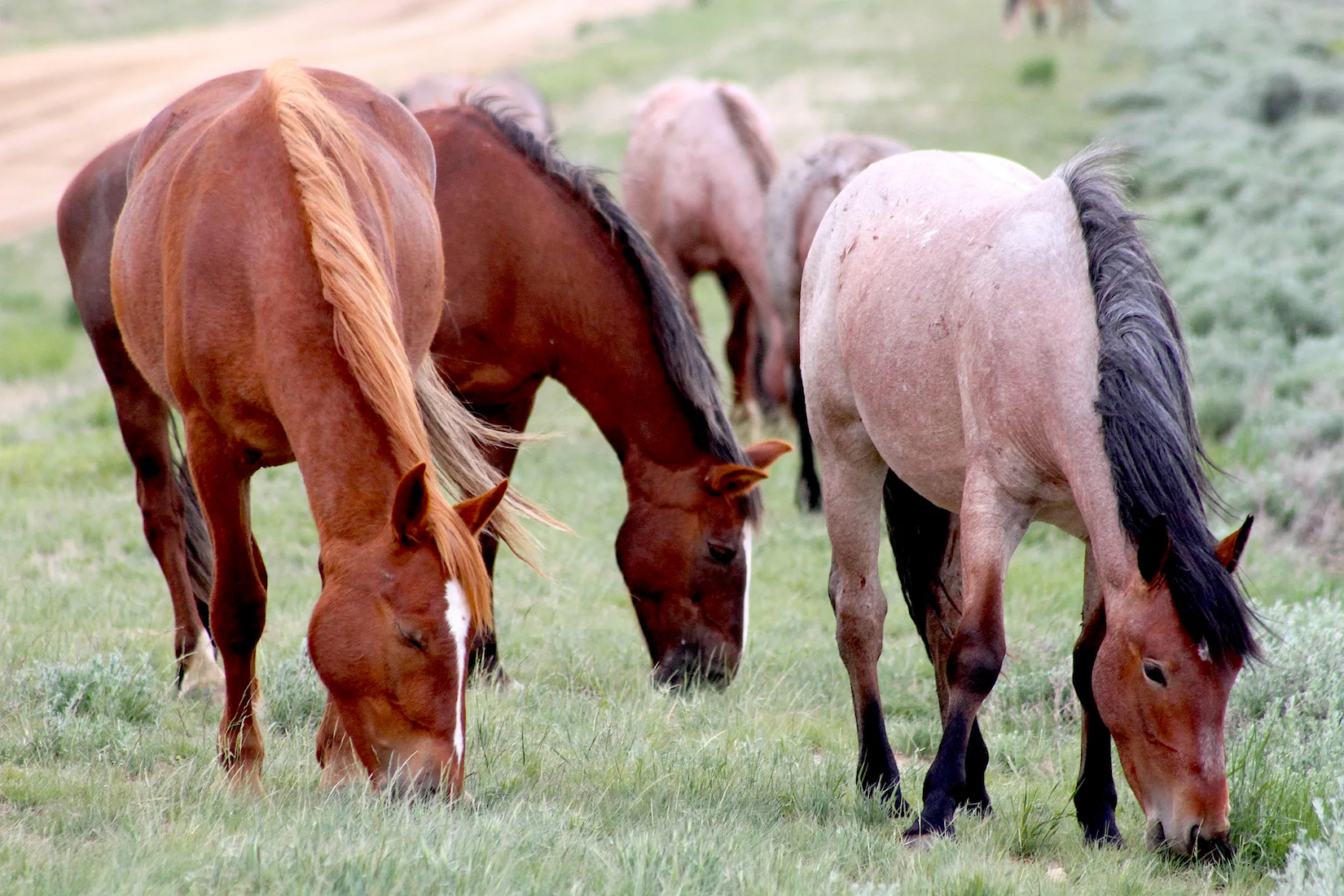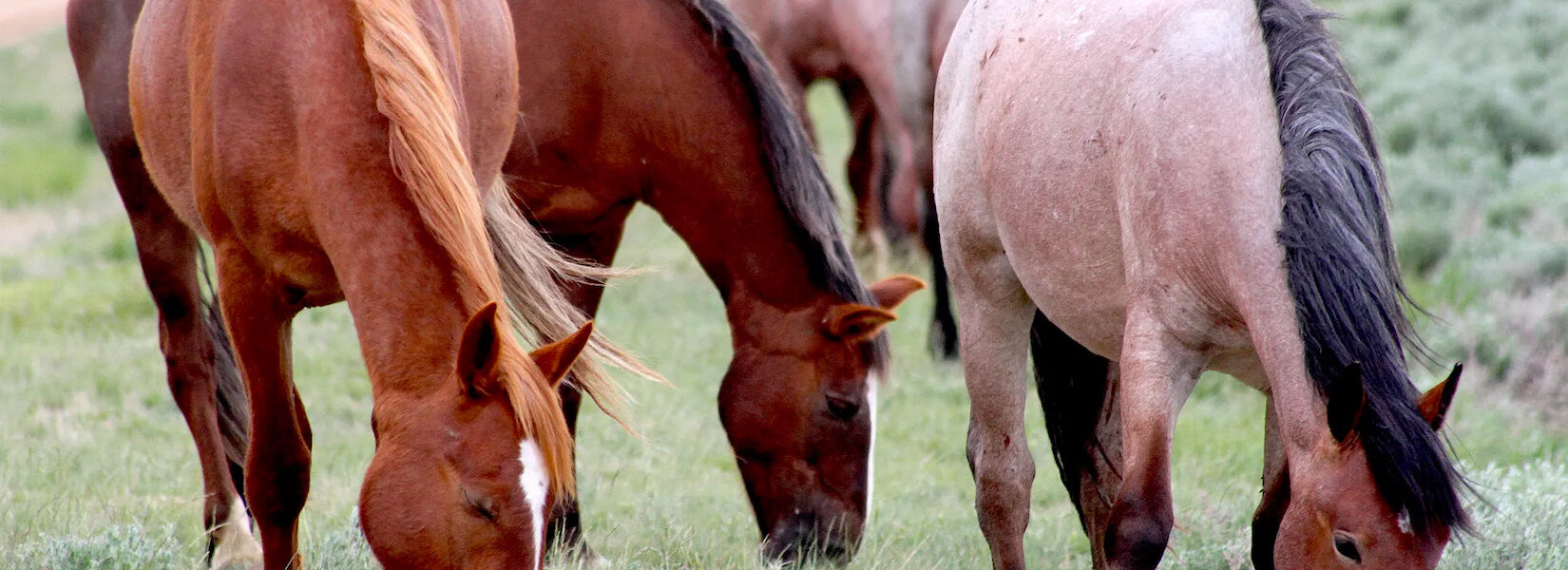BLM wins two lawsuits, clearing way for elimination of two Wyoming wild horse herds

• Decisions affirm federal government’s plans for horses in the ‘checkerboard’ region, where the feral equines’ presence is particularly controversial. An appeal has already been filed.
By Mike Koshmrl, WyoFile.com
WHITE MOUNTAIN—“That’s a lot of horses,” lamented Cheyenne resident Robyn Smith from a high-desert ridgeline.
It wasn’t her first exasperated exclamation. “Argh, oh crap,” was her immediate reaction to learning a federal judge had given the Bureau of Land Management the OK to proceed with plans to fully remove two wild horse herds from the landscape in southwest Wyoming.
A retired architect donning a “Return to Freedom” ball cap that featured a bucking mustang, Smith proudly described herself as a wild horse advocate. On this crisp Thursday morning in the hill country north of Interstate 80, she was doing one of her favorite things: Watching mustangs.
Smith’s interest in the equines — an icon of the West, albeit a nonnative one — had evolved organically into activism, stemming from a wildlife photography hobby. “We started doing more horse photography,” she said, “and then we started [wondering], ‘Well, what do you mean you’re going to round them up?’”
Soon, Smith was invested enough that she was sitting through wild horse-related legal proceedings and traveling to observe roundups — government run wild-horse gathers exactly like what was happening in the distance.
While Smith and a dozen or so others watched on for hours, a helicopter commissioned by the Bureau of Land Management herded one band of horses, then another, toward a trap. Once inside, they were sorted and trucked away.
The animals were members of what the BLM considers the White Mountain Herd. It’s vastly overpopulated, at least going by what the federal agency considers an “appropriate” number for this landscape. By day’s end, 144 animals — 52 stallions, 63 mares and 29 foals — had been removed, which meant the crews were almost exactly a quarter of the way to their goal of taking 586 mustangs off the range over the next couple weeks.
The White Mountain Herd’s horses are well known enough that they’re being allowed to persist. The BLM even advertises a scenic drive that winds through the heart of the herd management area. The plan is to maintain in the neighborhood of 205 to 300 horses in this region, which reaches from Rock Springs northwest to Seedskadee National Wildlife Refuge.
The Adobe Town Herd, in the Red Desert, is also being allowed to persist: BLM plans call for 225-450 horses here.
The neighboring Salt Wells and Great Divide Basin herds, meanwhile, are slated for elimination.
Wild horses compete with sheep, cattle and native wildlife for forage and other resources. That fact is particularly problematic in the eyes of some, and a prime driver of horse policy in this “checkerboard” swath of southwest Wyoming where private and federal land interchange in square-mile blocks that meet at the corners. The cattle and sheep-centric Rock Springs Grazing Association owns and leases about 1.1 million acres of private land in the checkerboard — and for decades fought the BLM over wild horses.
Litigation and more litigation
A year ago, the association sued, asking a court to compel federal land managers to remove free-ranging mustangs from their unfenced land.
After the BLM finalized an environmental impact statement calling for trimming the two herds and eliminating two others in spring 2023, a coalition of 11 wild-horse advocates came together to file a suit of their own challenging the decision.
U.S. District Court of Wyoming Judge Kelly Rankin, a Biden administration appointee, ruled in the BLM’s favor in both lawsuits on Wednesday.
“The Court agrees that … wild horses are improperly maintained on private lands,” the federal judge wrote in his decision on the Rock Springs Grazing Association’s complaint. “However, this maintenance, although ‘improper,’ does not necessarily require an immediate remedy.”
Rankin again sided with the government on each of the “litany” of claims brought by wild horse advocates, who argued the BLM arbitrarily and capriciously violated the Wild Free-Roaming Horses and Burros Act of 1971 and several other federal laws.
“Ultimately, however, the Court finds that each contention fails for either conflating the [BLM’s Resource Management Plan amendment] with a removal decision, misconstruing BLM’s obligations, or [because it is] contradicted by the record,” the judge wrote.
Lyons, Colorado resident Carol Walker was one of the plaintiffs. The day after Rankin’s ruling, she joined Smith on the ridgeline observing the roundup.
“I don’t do it because I like it,” Walker said. “It’s because I know the contractors will treat the horses better if there’s public here.”
Walker joined an appeal filed Friday in the Tenth Circuit Court of Appeals.
“My concern is the BLM is going to try to zero out these herds as fast as they can,” she said, “before our appeal even gets here.”
Represented by Eubanks and Associates, a similar coalition of wild horse advocates, environmental groups and individuals joined the appeal.
“We expected this case to be decided by a higher court, and we are returning to the Tenth Circuit Court of Appeals, where we have already twice prevailed in defending the Red Desert’s wild horses from this special-interest-driven eradication plan,” Suzanne Roy, executive director of American Wild Horse Conservation, said in a statement.
A phone call to the Rock Springs Grazing Association went unreturned.
Because of the protracted legal battle that’s likely to be extended further yet, it’s unlikely that BLM will immediately remove the entire Salt Wells and Great Divide Basin herds, said Brad Purdy, the agency’s deputy state director for communications. Although the agency completed a revision to its Resource Management Plan for wild horses — and Rankin upheld that plan — there’s still a requirement to study the action of eliminating a herd under the National Environmental Policy Act.
Roundups could continue
BLM-Wyoming started that NEPA study process in June, proposing to remove roughly 5,000 mustangs from three of the four horse management areas in the Rock Springs Field Office — including the two complete herd eliminations. With the appeal expected, though, it’s unlikely that the required environmental assessment will be completed anytime soon, Purdy said.
That’s not to say federal contractors will stop rounding up horses in the checkerboard anytime soon.
Nationally, BLM is aiming to take 20,000 wild horses off the landscape in 2024. Numbers have come down from the high point, but the current population of about 74,000 horses and wild burros nationwide is still nearly three times the “appropriate” management level — a dynamic that holds true in southwest Wyoming, where there are thousands more horses than the agency and many residents desire.
“Could BLM do a gather to bring those [herds] back down to the [target population]? I think we could,” Purdy said. “But I don’t think we could zero out the herd, because that’s under litigation.” Essentially, intensive roundups throughout the region could continue — and if they do, it’ll put BLM in a better position to complete the whole herd removals, if or when the litigation wraps up.
For horse advocates, those roundups aren’t especially fun. Descriptions like “unspeakable” and “cruel” were common among the observers. Cheyenne resident Barry Smith — Robyn Smith’s husband — wouldn’t even watch.
“I get too emotional,” he explained from the cab of his SUV, where he waited out the roundup.
“Some of the pilots are better than others,” Barry Smith said. “Some are pretty good, and if the horses slow down, they kind of hold back and stay higher. Others overrun them, I think.”
Jay D’Ewart, the BLM Rock Springs Field Office’s wild horse and burro specialist, was the man in charge Thursday. While taking lunch in his pickup, he professed to having something in common with the wild horse advocates who kept an eye on his operation.
“I’m just like them, I love horses,” D’Ewart said, “I own them, I use them, I ride them — I just like it.”
He loved seven previously rounded-up mustangs so much, in fact, that he took them home. Some of those horses came from herds in line to be eliminated.
D’Ewart hadn’t yet caught up on the court ruling, having been tied up prepping for the weeks-long roundup. But it’s a decision that could make him a busy man.
• WyoFile is an independent nonprofit news organization focused on Wyoming people, places and policy.





